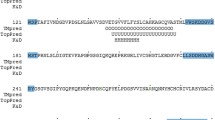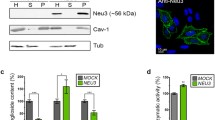Abstract
Neuropilins are involved in angiogenesis and neuronal development. The membrane proximal domain of neuropilin-1, called c or MAM domain based on its sequence conservation, has been implicated in neuropilin oligomerization required for its function. The c/MAM domain of human neuropilin-1 has been recombinantly expressed to allow for investigation of its propensity to engage in molecular interactions with other protein or carbohydrate components on a cell surface. We found that the c/MAM domain was heavily O-glycosylated with up to 24 monosaccharide units in the form of disialylated core 1 and core 2 O-glycans. Attachment sites were identified on the chymotryptic c/MAM peptide ETGATEKPTVIDSTIQSEFPTY by electron-transfer dissociation mass spectrometry (ETD-MS/MS). For highly glycosylated species consisting of carbohydrate to about 50 %, useful results could only be obtained upon partial desialylation. ETD-MS/MS revealed a hierarchical order of the initial O-GalNAc addition to the four different glycosylation sites. These findings enable future functional studies about the contribution of the described glycosylations in neuropilin-1 oligomerization and the binding to partner proteins as VEGF or galectin-1.
As a spin-off result the sialidase from Clostridium perfringens turned out to discriminate between galactose- and N-acetylgalactosamine-linked sialic acid.






Similar content being viewed by others
Abbreviations
- CID:
-
Collision-induced dissociation
- ETD:
-
Electron-transfer dissociation
- FPLC / HPLC:
-
Fast protein / High pressure liquid chromatography
- Gal:
-
Galactose
- Gal1:
-
Galectin1
- GlcNAc:
-
N-acetylglucosamin
- HEK293 cells:
-
Human embryonic kidney cells
- Hex:
-
Hexose
- HexNAc:
-
N-acetylhexosamine
- HUVEC:
-
Human umbilical vein endothelial cell
- Neu5Ac:
-
N-acetylneuraminic acid
- Nrp1:
-
Neuropilin-1
- (O-)GalNAc:
-
(O-linked) N-acetylgalactosamine
- (RP)-LC-ESI-MS:
-
(reversed phase)-liquid chromatography-electrospray ionization mass spectrometry
- PGC:
-
Porous graphitic carbon
- Q-TOF:
-
Quadrupole - Time of flight
- SPE:
-
Solid phase extraction
- VEGF:
-
Vascular endothelial growth factor
- VEGFR2:
-
Vascular endothelial growth factor receptor 2
References
Giger, R.J., et al.: Semaphorin III: role in neuronal development and structural plasticity. Prog. Brain Res. 117, 133–149 (1998)
Frankel, P., et al.: Chondroitin sulphate-modified neuropilin 1 is expressed in human tumour cells and modulates 3D invasion in the U87MG human glioblastoma cell line through a p130Cas-mediated pathway. EMBO Rep. 9(10), 983–989 (2008)
Shintani, Y., et al.: Glycosaminoglycan modification of neuropilin-1 modulates VEGFR2 signaling. EMBO J. 25(13), 3045–3055 (2006)
Appleton, B.A., et al.: Structural studies of neuropilin/antibody complexes provide insights into semaphorin and VEGF binding. EMBO J. 26(23), 4902–4912 (2007)
Chen, R., et al.: Glycoproteomics analysis of human liver tissue by combination of multiple enzyme digestion and hydrazide chemistry. J. Proteome Res. 8(2), 651–661 (2009)
Hsieh, S.H., et al.: Galectin-1, a novel ligand of neuropilin-1, activates VEGFR-2 signaling and modulates the migration of vascular endothelial cells. Oncogene 27(26), 3746–3753 (2008)
Meynier, C., Guerlesquin, F., Roche, P.: Computational Studies of Human Galectin-1: Role of Conserved Tryptophan Residue in Stacking Interaction with Carbohydrate Ligands. J. Biomol. Struct. Dyn. 27(1), 49–57 (2009)
Carlsson, M.C., et al.: Galectin-1-binding glycoforms of haptoglobin with altered intracellular trafficking, and increase in metastatic breast cancer patients. PLoS One 6(10), e26560 (2011)
Quinta, H.R., et al.: Glycan-dependent binding of galectin-1 to neuropilin-1 promotes axonal regeneration after spinal cord injury. Cell Death Differ. 21(6), 941–955 (2014)
Steentoft, C., et al.: Precision mapping of the human O-GalNAc glycoproteome through SimpleCell technology. EMBO J. 32(10), 1478–1488 (2013)
Windwarder, M., Altmann, F.: Site-specific analysis of the O-glycosylation of bovine fetuin by electron-transfer dissociation mass spectrometry. J. Proteomics 108, 258–268 (2014)
Pabst, M., et al.: Glycan profiles of the 27 N-glycosylation sites of the HIV envelope protein CN54gp140. Biol. Chem. 393(8), 719–730 (2012)
Edge, A.S., Spiro, R.G.: Presence of an O-glycosidically linked hexasaccharide in fetuin. J. Biol. Chem. 262(33), 16135–16141 (1987)
Pabst, M., et al.: IL-1beta and TNF-alpha alter the glycophenotype of primary human chondrocytes in vitro. Carbohydr. Res. 345(10), 1389–1393 (2010)
Wuhrer, M., Deelder, A.M., van der Burgt, Y.E.M.: Mass Spectrometric Glycan Rearrangements. Mass Spectrom. Rev. 30(4), 664–680 (2011)
Everest-Dass, A.V., et al.: Structural Feature Ions for Distinguishing N- and O-Linked Glycan Isomers by LC-ESI-IT MS/MS. J. Am. Soc. Mass Spectrom. 24(6), 895–906 (2013)
Kolarich, D., et al.: The Minimum Information Required for a Glycomics Experiment (MIRAGE) Project: Improving the Standards for Reporting Mass-spectrometry-based Glycoanalytic Data. Mol. Cell. Proteomics 12(4), 991–995 (2013)
Taylor, C.F., et al.: The minimum information about a proteomics experiment (MIAPE). Nat. Biotechnol. 25(8), 887–893 (2007)
Stavenhagen, K., et al.: Quantitative mapping of glycoprotein micro-heterogeneity and macro-heterogeneity: an evaluation of mass spectrometry signal strengths using synthetic peptides and glycopeptides. J. Mass Spectrom. 48(6), 627–639 (2013)
Marx, K., Kiehne, A., Meyer M.: amaZon speed ETD: Exploring glycopeptides in protein mixtures using Fragment Triggered ETD and CaptiveSpray nanoBooster, Bruker application note LC-MS-93, 04/2014, Bruker Daltonics GmbH, http://bdal.de (2014). Accessed 23 October 2014
Liu, J., McLuckey, S.A.: Electron Transfer Dissociation: Effects of Cation Charge State on Product Partitioning in Ion/Ion Electron Transfer to Multiply Protonated Polypeptides. Int. J. Mass Spectrom. 330–332, 174–181 (2012)
Good, D.M., et al.: Performance characteristics of electron transfer dissociation mass spectrometry. Mol. Cell. Proteomics 6(11), 1942–1951 (2007)
Catalina, M.I., et al.: Electron transfer dissociation of N-glycopeptides: loss of the entire N-glycosylated asparagine side chain. Rapid Commun. Mass Spectrom. 21(6), 1053–1061 (2007)
Mormann, M., Paulsen, H., Peter-Katalinic, J.: Electron capture dissociation of O-glycosylated peptides: radical site-induced fragmentation of glycosidic bonds. Eur. J. Mass Spectrom. 11(5), 497–511 (2005)
Thaysen-Andersen, M., et al.: Site-specific characterisation of densely O-glycosylated mucin-type peptides using electron transfer dissociation ESI-MS/MS. Electrophoresis 32(24), 3536–3545 (2011)
Takahashi, K., et al.: Clustered O-glycans of IgA1: defining macro- and microheterogeneity by use of electron capture/transfer dissociation. Mol. Cell. Proteomics 9(11), 2545–2557 (2010)
Brockhausen, I.: Pathways of O-glycan biosynthesis in cancer cells. Biochim. Biophys. Acta 1473(1), 67–95 (1999)
Djordjevic, S., Driscoll, P.C.: Targeting VEGF signalling via the neuropilin co-receptor. Drug Discov. Today 18(9–10), 447–455 (2013)
Kolarich, D., et al.: Comprehensive glyco-proteomic analysis of human alpha1-antitrypsin and its charge isoforms. Proteomics 6(11), 3369–3380 (2006)
Acknowledgments
The authors thank Daniel Kolarich for fruitful discussion. We wish to acknowledge the input of the OPPF (Oxford protein production facility, Didcott, UK) in supporting initial mammalian protein expression trials of the c/MAM domain.
Compliance with Ethical Standards
No ethical objections emanate from this work.
Conflict of interest
The authors declare that they have no conflict of interest.
Author information
Authors and Affiliations
Corresponding author
Electronic supplementary material
Below is the link to the electronic supplementary material.
Supplementary Figure 1
Quality control of purified recombinant c/MAM domain. Size exclusion chromatography and SDS-PAGE demonstrate high protein purity and an apparent size of ~ 25 kDa. (GIF 58 kb)
Supplementary Figure 2
Proof of novel α2-3,6,8 neuraminidase substrate specificity. Panel A shows the chromatograms of the two main O-glycan species, derived from reductive beta elimination of neuraminidase treated chymotryptic recombinant neuropilin-1. The structure of the core 1 glycan was verified by positive mode CID fragmentation, giving the feature ion 515.1 m/z (panel B). Panel C shows a CID fragmentation spectrum of the main fetuin O-glycan being sialylated on the galactose. In contrast to panel C, 515 m/z shows no signal whereas a specific feature ion at 454.1 m/z (Neu5Ac-Gal) appears. (GIF 76 kb)
Supplementary Figure 3
Positive mode CID-MS/MS fragmentation spectra of some c/MAM O-glycan species. Precursor mass and charge form as well as inferred glycan structure are given in the respective top right corners of Panels A-D. Peak * in Panel D results from a glycan rearrangement during CID, which did, however, not affect data interpretation. (GIF 135 kb)
Supplementary table 1
(DOCX 25 kb)
Supplementary table 2
(DOCX 30 kb)
Rights and permissions
About this article
Cite this article
Windwarder, M., Yelland, T., Djordjevic, S. et al. Detailed characterization of the O-linked glycosylation of the neuropilin-1 c/MAM-domain. Glycoconj J 33, 387–397 (2016). https://doi.org/10.1007/s10719-015-9602-x
Received:
Revised:
Accepted:
Published:
Issue Date:
DOI: https://doi.org/10.1007/s10719-015-9602-x




